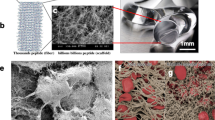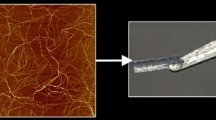Abstract
Peptide self-assembly is an important field in biomaterials in which short peptides are designed to aggregate into nanostructures that often form hydrogels. These peptides are typically made using solid-phase peptide synthesis (SPPS), a technique in which amino acids are added sequentially to a growing chain. This technique has been used to synthesize peptides with more than 100 amino acids. However, self-assembling peptides are designed to aggregate in solution, which often reduces coupling efficiency during synthesis and makes purification more difficult. Here, an outline of solid-phase peptide synthesis is provided, along with steps that can be used to improve the synthetic yield and purification of self-assembling peptides for regenerative medicine applications.
Access this chapter
Tax calculation will be finalised at checkout
Purchases are for personal use only
Similar content being viewed by others
References
Webber MJ, Appel EA, Meijer EW, Langer R (2016) Supramolecular biomaterials. Nat Mater 15:13–26
Hartgerink JD, Beniash E, Stupp SI (2001) Self-assembly and mineralization of peptide-amphiphile nanofibers. Science 294:1684–1688
Palomo JM (2014) Solid-phase peptide synthesis: an overview focused on the preparation of biologically relevant peptides. RSC Adv 4:32658–32672
Coin I, Beyermann M, Bienert M (2007) Solid-phase peptide synthesis: from standard procedures to the synthesis of difficult sequences. Nat Protoc 2:3247–3256
Cui H, Pashuck ET, Velichko YS et al (2010) Spontaneous and x-ray-triggered crystallization at long range in self-assembling filament networks. Science 327:555–559
Jayawarna V, Ali M, Jowitt TA et al (2006) Nanostructured hydrogels for three-dimensional cell culture through self-assembly of fluorenylmethoxycarbonyl–dipeptides. Adv Mater Weinheim 18:611–614
Author information
Authors and Affiliations
Corresponding author
Editor information
Editors and Affiliations
Rights and permissions
Copyright information
© 2018 Springer Science+Business Media, LLC, part of Springer Nature
About this protocol
Cite this protocol
Thomas Pashuck, E. (2018). Synthesis of Self-Assembling Peptide-Based Hydrogels for Regenerative Medicine Using Solid-Phase Peptide Synthesis. In: Chawla, K. (eds) Biomaterials for Tissue Engineering. Methods in Molecular Biology, vol 1758. Humana Press, New York, NY. https://doi.org/10.1007/978-1-4939-7741-3_14
Download citation
DOI: https://doi.org/10.1007/978-1-4939-7741-3_14
Published:
Publisher Name: Humana Press, New York, NY
Print ISBN: 978-1-4939-7739-0
Online ISBN: 978-1-4939-7741-3
eBook Packages: Springer Protocols




